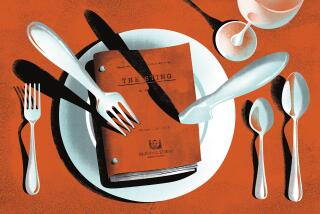Classic Hollywood: Film pioneers describe early days in ‘My First Time in Hollywood’
Everyone’s first time was different.
Screenwriter Ben Hecht said his first day in Hollywood in 1926 was “like a year in Siberia.” Screenwriter Frances Marion arrived in 1912 and was shocked when she tried to find an apartment.
“There were vacancies galore, but tacked over many of the rental signs was this ominous edict: ‘No Jews, actors or dogs allowed.’ My blood boiled.”
Hecht and Marion’s reminiscences are included in the new book on the early days of filmmaking, “My First Time in Hollywood: Stories From the Pioneers, Dreams and Misfits Who Made the Movies,” edited and annotated by film historian and writer Cari Beauchamp, whose previous work includes the book “Without Lying Down: Frances Marion and the Powerful Women of Early Hollywood.”
Culled from autobiographies, letters, speeches, oral histories and memories, “My First Time” features such actors as Mary Pickford, Harold Lloyd, Lillian Gish, Gloria Swanson and Colleen Moore, directors Cecil B. DeMille and King Vidor and screenwriter Anita Loos recalling their first impressions of Hollywood, their determination to find work and their love and passion for filmmaking.
Beauchamp had a couple of overarching goals in choosing subjects for her book: She wanted half of them to be women. And she wanted only a third of them to be actors; for the rest, she wanted crew — “people we don’t know,” she said. “To me it’s important to always put the spotlight on how truly collaborative [filmmaking] is. Everyone had to bring their best.”
Beauchamp casts the spotlight on cinematographer Karl Brown, who got his first big break as the assistant to D.W. Griffith’s cinematographer, Billy Bitzer; set decorator Winfrid Kay Thackrey, who was determined to persuade studios to hire a woman; and even Valeria Belletti, Samuel Goldwyn’s young secretary who helped get beau Gary Cooper his first major film.
When Gish arrived with her sister and mother in 1913, Los Angeles had about 300,000 residents with “wide boulevards, churches and Spanish-style houses,” she wrote in an excerpt taken from her 1969 memoir, “The Movies, Mr. Griffith, and Me.” “Nearby were ocean and desert, snow-capped mountains and green valleys, Spanish missions and fruit farms.”
When a teenage Mary Pickford came out west in 1910 to work with D.W. Griffith, she noted in a bit taken from her 1955 autobiography, “Sunshine and Shadows”: “Studios were all on open lots — roofless and without walls, which explains the origin of the terms ‘on the lot.’ Our studio consisted of an acre of ground, fenced in, and a large wooden platform, hung with cotton shades that were pulled on wires overhead. On a windy day, our clothes and curtains on the set would flap loudly in the breeze.”
Compiling these accounts, Beauchamp said, “you realize what a real community it was — how they knew each other, how they reflected upon each and how they counted on each other for different things.”
She also noted that there is “always a dash of serendipity” in their stories. As well as hustle, determination and perseverance.
“These people were greeted with the word ‘no’ time and time again and they kept coming back,” she said.
Though most of the people featured in the book arrived on the West Coast in their teens and 20s, Beauchamp included a few veterans like Maurice Leloir, a well-known French painter, designer and illustrator who came to Hollywood in his late 70s in 1928 to supervise the sets and costumes for historical accuracy on Douglas Fairbanks’ “The Iron Mask.”
Leloir, who had never traveled outside of France, was so smitten with Los Angeles that he wrote the book “Five Months in Hollywood With Douglas Fairbanks.”
As for Moore, one of the biggest stars in the ‘20s in such films as “Flaming Youth” and “Lilac Time,” she found love at first sight when she arrived in 1916 as a star-struck 15-year-old with a six-month contract.
“The trip to California took three days and three nights. ... When we came out of the desert into California, I ran out to the observation platform to stare at the snowcapped mountains, the green orange groves, the palm trees, and the brilliant sky,” she wrote in an excerpt from her 1968 autobiography, “Silent Star.” “I knew this was my land. There was where I belonged.”
For more Classic Hollywood, follow us on Facebook and subscribe to the newsletter.
More to Read
Only good movies
Get the Indie Focus newsletter, Mark Olsen's weekly guide to the world of cinema.
You may occasionally receive promotional content from the Los Angeles Times.







